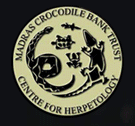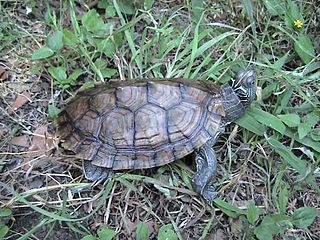
Herpetology is the branch of zoology concerned with the study of amphibians and reptiles. Birds, which are cladistically included within Reptilia, are traditionally excluded here; the scientific study of birds is the subject of ornithology.

The Madras Crocodile Bank Trust and Centre for Herpetology (MCBT) is a reptile zoo and herpetology research station, located 40 kilometres (25 mi) south of the city of Chennai, in state of Tamil Nadu, India. The centre is both a registered trust and a recognized zoo under the Wildlife (Protection) Act, 1972 and comes under the purview of the Central Zoo Authority, Ministry of Environment and Forests, Government of India. It was established with the aim of saving three Indian endangered species of crocodile—the marsh or mugger crocodile, the saltwater crocodile, and the gharial, which at the time of founding of the trust were all nearing extinction.

Archie Fairly Carr, Jr. was an American herpetologist, ecologist, and conservationist. He was a Professor of Zoology at the University of Florida and an acclaimed writer on science and nature. He brought attention to the world's declining sea turtle populations due to over-exploitation and habitat loss. Wildlife refuges in Florida and Costa Rica have been named in his honor.
Craig Stanford is Professor of Biological Sciences and Anthropology at the University of Southern California. He is also a Research Associate in the herpetology section of the Los Angeles County Natural History Museum. He is known for his field studies of the behavior, ecology and conservation biology of chimpanzees, mountain gorillas and other tropical animals, and has published more than 140 scientific papers and 17 books on animal behavior, human evolution and wildlife conservation. He is best known for his field study of the predator–prey ecology of chimpanzees and the animals they hunt in Gombe National Park, Tanzania, and for his long term study of the behavior and ecology of chimpanzees and mountain gorillas in Bwindi Impenetrable National Park, Uganda.
The American Society of Ichthyologists and Herpetologists (ASIH) is an international learned society devoted to the scientific studies of ichthyology and herpetology. The primary emphases of the society are to increase knowledge about these organisms, to communicate that knowledge through publications, conferences, and other methods, and to encourage and support young scientists who will make future advances in these fields. The programs of the American Society of Ichthyologists and Herpetologists are part of a global effort to interpret, understand, and conserve the Earth's natural diversity and to contribute to the wise use of natural resources for the long-term benefit of humankind.

Graptemys is a genus of freshwater turtles containing 14 species, commonly known as map turtles. Graptemys are small to medium-sized turtles that are sexually dimorphic, with females attaining as much as twice the length and ten times the mass as males in some species. Depending on the species, adult males range from 7–16 cm (2.75–6.25 in), adult females 10–29.5 cm (4–11.62 in), and hatchlings 2.5–3.8 cm (1–1.5 in), although some sources indicate female Barbour's map turtles grow to 33 cm (13 in) in length. Most species have a distinctive dark pigmented keel that is often notched or serrated running down the center of the carapace and serrated scutes on the rear margin. The head, neck, and limbs exhibit bold patterns of yellow lines and spots against darker green, olive, or black base colors. The patterns on the head can be important characters in identifying the various species. The common name "map turtle" is derived from the intricate patterns on their shells that are suggestive of topographical maps, although the patterns are more apparent in some species than others, and often become obscure in older specimens. Some species are occasionally called "sawbacks", in reference to the serrated keels on their shell.

Herping is the act of searching for amphibians or reptiles. The term, often used by professional and amateur herpetologists, comes from the word "herp", which comes from the same Greek root as herpetology, herpet-, meaning "creeping". The term herp is a shorthand used to refer to the two classes of ectothermic tetrapods.
The Society for the Study of Amphibians and Reptiles (SSAR) is an international herpetological society. It is a non-profit organization supporting education, conservation, and research related to reptiles and amphibians. Regular publications include the Journal of Herpetology and Herpetological Review. It is the largest international herpetological society, and is recognized worldwide for having the most diverse program of publications, meetings, and other activities.
Herpetological society is a commonly used term for a club or organized group of reptile and amphibian enthusiasts. The term is derived from herpetology - the branch of zoology dealing with the study of those organisms.
J. Whitfield "Whit" Gibbons is an American herpetologist, author, and educator. He is Professor Emeritus of Ecology, University of Georgia, and former Head of the Environmental Outreach and Education program at the Savannah River Ecology Laboratory (SREL).
Lee Fitzgerald is Professor of Zoology and Faculty Curator of Amphibians and Reptiles in the Department of Wildlife and Fisheries Sciences at Texas A&M University. His biological specialty is the evolutionary ecology and conservation biology of amphibians and reptiles (herpetology). Fitzgerald is a former editor of Herpetological Monographs.
John L. Behler was an American naturalist, herpetologist, author, and activist known for his work in conserving endangered species of turtles, snakes, and other reptiles. He served as curator of herpetology at the Bronx Zoo, part of the Wildlife Conservation Society from 1976 to 2006. He co-chaired the IUCN Tortoise and Freshwater Turtle Specialist Group, and was a founding member of the Turtle Survival Alliance, which co-present the Behler Turtle Conservation Award with the Turtle Conservancy and Turtle Conservation Fund. The Behler Turtle Conservation Award is a major annual award to honor leadership in the field of freshwater turtle and tortoise conservation. The Turtle Conservancy named its captive breeding center, the Behler Chelonian Center, in his honor.
Richard Bruce Bury, a pioneer in the study of herpetofauna, is an American conservationist, herpetologist, and natural historian and Scientist Emeritus of the United States Geological Survey. Bury, C. Kenneth Dodd, Jr. and Gary Fellers were the first to suggest widespread amphibian declines were progressing. In 1972, Bury became the first person hired by the United States Department of the Interior under the specific title of Herpetologist. In 2009, the American Society of Ichthyologists and Herpetologists (ASIH) made Bury the 11th herpetologist awarded the annual Henry S. Fitch Award for Excellence in Herpetology. Bury is a founding governing board member and executive editor of the journal Herpetological Conservation and Biology. For more than 30 years, Bury has studied herpetofauna ecology and conservation, including the effects of invasive species and wildfire on populations. Thanks in part to his efforts, herpetofauna are recognized as important indicators of ecosystem health.
Walter E. Meshaka Jr. is an American herpetologist and natural historian. He was the supervisory curator for the four National Parks in southern Florida from 1995 to 2000. In 2000 he became the Senior Curator of Zoology and Botany at the State Museum of Pennsylvania in Harrisburg, Pennsylvania. His research has been covered by Lawrence Journal-World, among other news outlets.
Joseph Thomas Collins, Jr. was an American herpetologist. A graduate of the University of Cincinnati, Collins authored 27 books and over 300 articles on wildlife, of which about 250 were on amphibians and reptiles. He was the founder of the Center for North American Herpetology (CNAH). He died while studying amphibians and reptiles on St. George Island, Florida on 14 January 2012. "For 60 years I was obsessed with herpetology," claimed Joe Collins
Richard Carl "Dick" Vogt was an American herpetologist based in Brazil. He was the director of the Centro de Estudos de Quelônios da Amazônia at the National Institute of Amazonian Research (INPA).

The Turtles of Venezuela is an identification guide of the Testudines families that are found in Venezuela, written by zoologist Pedro Trebbau and herpetologist Peter Pritchard. It was originally published in English in 1984, by the Society for the Study of Amphibians and Reptiles as the Number 2 of the series Contributions to herpetology.
Kongahage Anslem Lawrence de Silva is a Sri Lankan biologist and herpetologist recognised as the father of modern herpetology in Sri Lanka. His career spanned for more than five decades; de Silva has contributed to the field of zoology with much research and numerous publications particularly on crocodiles, snakes and lizards.
Margaret "Meg" McBride Stewart was an American herpetologist, known for her research on the amphibians of Malawi, the Caribbean, and the United States. She was a professor at the State University of New York at Albany. She served as president of the American Society of Ichthyologists and Herpetologists and the Society for the Study of Amphibians and Reptiles. The puddle frog Phrynobatrachus stewartae was named in her honour.
Subramanian Bhupathy (1963–2014) was an Indian herpetologist, wildlife biologist and researcher. He was a principal scientist at the Salim Ali Centre for Ornithology and Natural History (SACON). He headed a three-year study on the patterns of distribution of selected faunal groups on the Agasthyamalai hills. He worked on lizards, amphibians and birds and his contributions and works were more focused on reptiles. Dr Bhupathy was noted for work on pythons and python ecology in India and Indian turtles and tortoises.





